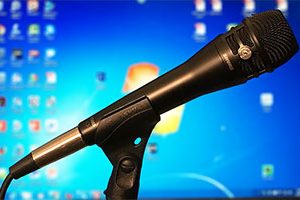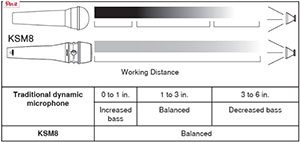Mixing music inside a studio whether in a professional studio or your home studio usually creates a very familiar and ideal condition. These conditions can sometimes cloud our judgment especially in what we are hearing. Thus it is strongly advised that you listen and check your mix outside of the confines of your studio. Here is an old school approach to your critical listening stage and that is outdoors.
Start by asking the question “why?” Why should you do this process and how important to your mix? The idea is to listen to your mix in your usual daily environment.
Read more here: http://en.audiofanzine.com/recording-mixing/editorial/articles/critical-listening-outside-your-studio.html
Archives for April 2017
Recording 50s Style
Many oldies now-a-days feel that nostalgia that hits back at them. When I mean oldies, I mean VERY old fellows. The music back then, in the 1950’s, was very much different – and of quality, apparently, as people are actually trying to recreate the sound. To be frank, I am not surprised as the 1950’s was a unique time, especially for music. To recreate it, you have to get the microphone placement JUST right, and you have to have the right brand and quality of instruments. Vocal compression is also a variable for the sound. Overall, the sounds of the 1950’s were very awesome, like I said, if people are really trying to recreate it.
Read more: Recording 50s Style
Our Review Of The Shure Dualdyne KSM8 Handheld Dynamic Microphone

The latest in our month of mic reviews here at Home Brew Audio is the Shure KSM8 Dualdyne handheld dynamic microphone. I briefly talked about this mic a couple weeks ago in my post “World’s First Dual Diaphragm Dynamic Microphone.” That post also shows a video from the folks at Shure explaining what all the fuss is about this mic and its new technology. But this week I got my hands on one and ran it through several tests, comparing the mic to its popular sibling, the Shure SM58, and running it through our PA system so we could hear it doing what it was designed to do – be an awesome live vocal mic.
I encourage you to either check out my first post linked above and/or to visit the Shure site here to dig deeper into all the technical specs. This review will mostly discuss the basics and focus on what’s really important about any microphone – how it sounds.
What It Is
The “fuss” about this mic is that it is the first handheld dynamic mic with two diaphragms inside. Shure (the first mic manufacturer to create a mic you could on stage back in the 1939 with what became known as “The Elvis Mic”) says that they had to reinvent the way microphones are made in order to create the KSM8. The 2 diaphragms allow this dynamic mic to do some cool things. Here are the main bullet points:
- It sounds natural across the frequency spectrum – basically meaning that neither the lows nor the highs are excessive or lost.
- It rejects sounds from the side and the rear extremely well, which is really important on a live stage. This helps reduce feedback and makes the voice sound cleaner against other instruments, a crowd, PA monitors, etc.
- It has a large “sweet-spot” – which means a singer/performer doesn’t have to keep the mic a very specific distance from their mouth to get consistent tone, like most live mics.
- There is little-to-no proximity effect. This is related to the last point, and means your voice won’t sound extra deep when your lips are right up on the mic, and then sound really thin if you back up a few inches.
So How Did It Sound?
Awesome. End of review. OK, just kidding. Since the KSM8 is designed to be a live vocal mic, I thought the best test would be to listen to it through PA speakers. So that’s what we did.
First, I set up a Shure SM58 dynamic handheld mic for vocals, and a Shure SM57 (another dynamic mic) for my acoustic guitar (a Taylor 314ce, in case you were wondering:)). Then I connected my Zoom H2 Handy Recorder to the output of my mixer to record the results. Then I called in my wife – the lovely and talented Lisa Theriot – to listen to me sing and play one of our songs (William Tell from my album, “Outlaws and Bystanders“). I asked her to not look at the vocal mic so she wouldn’t be influenced by knowing which mic she was hearing. After playing a couple of verses and a chorus, I stopped and switched in the KSM8. She actually said she liked “mic #1 (the SM58) better,” which really surprised me. I changed places with her while she played and sang. And I most definitely thought her voice sounded much better through the KSM8.
As we stood scratching our heads, we noticed that our indoor setup was seriously wonky for amplified live music. The speakers were on the floor in the living room with a vaulted ceiling, while the listener was behind a couch in the kitchen nook where the ceiling was only about 8 feet high. So we decided a more fair test would be to set up the entire thing outside.
We repeated the procedure on a warm Texas day in the back yard with no room (or furniture) adding to or taking away from the sound. I also decided to record the sound “through the air,” rather than using a feed from the mixer. So I set the H2 up about 10 feet in front of the speakers to capture the audio. I listened to Lisa play and sing some more, and again preferred the sound of the KSM8 on her voice. The best way I can describe it was that with the SM58, it sounded like Lisa singing through a microphone. But with the KSM8, it sounded like Lisa was singing right next to me WITHOUT a mic. It was all the nuances and subtleties of her un-amplified voice coming through the PA when she sang into the KSM8.
And this time, Lisa very much preferred the sound of my voice when singing through the KSM8. Her comments were that the voice through the PA sounded richer and fuller than the SM58. Standing behind the mic, I had to agree. This is an outstanding vocal mic for the stage.
Audio Results From Outdoor PA Tests
Below are audio samples of our outdoor PA test.
First is the SM58
Audio Player
And here is the KSM8
Audio Player
Audio Results From Studio Tests
Next, I wanted to do some more controlled recordings – without all the extra factors that could affect the audio recorded through a PA and then onto a handheld digital recorder (like the mic preamps in the mixing board, the power amplifier and the speakers, etc.). So I took the mics up to the studio and recorded some voice-over/narration audio through a Focusrite 2i2 audio interface. I did not use any kind of pop filter on either mic, so you will hear p-pops. I didn’t notice a difference in the sensitivity to plosives between the mics.
First is the SM58
Audio Player
And here’s the KSM8
Audio Player
I think the difference is huge – the KSM8 sounding much better. It was more crisp in the mids and highs while simultaneously being “meaty” in the lower ranges.
Comparison Of Tone 6 Inches Away

The last part of those studio tests was recorded at a distance of 6 inches from each microphone. The reason for that was to compare the tone changes as I moved further back. One of the key features of the KSM8 is a larger “sweet spot,” which allows the user more freedom to move without the audio suffering tone changes. See Figure 2. Traditionally, with most dynamic mics like the SM58, you have to stay the same distance from the mic or else the tone changes quite a lot – sounding deeper (more bass) when very close to the mic (this is called “proximity effect”), and sounding thinner with more mid and high frequencies coming through as you back away. With the KSM8, there should be much less change in tone as you back away.
In order to better test that feature, I excerpted just the section of audio recorded 6 inches away, and boosted the volume on both. In theory, the KSM should still retain much of its low frequencies and sound more balanced across the frequencies. Let’s hear for ourselves. I recommend listening with headphones.
Here is the SM58 six inches away from my mouth
Audio Player
And here is the KSM8 six inches away
Audio Player
Again, I definitely noticed a large difference in the KSM8, which retained more low frequencies as the distance increased and sounded more balanced across the entire spectrum.
In Summary
There is no doubt in my mind that the Shure KSM8 Dualdyne handheld dynamic is a superior microphone for live vocals. The new technology allows for cleaner, more natural, and more prevalent vocals, especially when on stage with other instruments. The only quibble I have is with the price, which at $499 is 5 times the price of the SM58. But if your livelihood depends on great sounding vocals in a live situation, the KSM is worth the price.
To find out more, or to buy one of your own, CLICK HERE.
Alpha Base: Analog Drum Machine And Synth In One
Jomox a Berlin-based company has recently announced the release of their new analog drum machine and synth in one machine, the Alpha Base.
Comes with some impressive features, Alpha Base is said to be the most versatile drum machine, Jomox has released. Featuring your basic drum kit created using onboard synth and extra slots for percussion add-ons using your SD card. Designer Jurgen Michaelis says this is the best sounding drum machine we have ever built.
Of course, it comes with an astonishing price but Jomox promises to compensate well with its features and boasting of adding and FM synth for that all in one experience.
Read more here: http://www.musictech.net/2017/04/alpha-base-analog-drum-machine-synth/
Multiband Compressors: They Doesn’t Have to Be Confusing
In audio recording, a compressor limits the input above a certain volume. A multi-band compressor does the same, but only to specific frequencies, not to the whole audio channel. For instance, you can use this to even out the low notes and make the bass more constant, or to select out stray sounds, to clean up vocals, fix bad drum noise, or add umph to your mid-ranges. You can make these changes without having to select out entire frequency ranges, the way you would with an equalizer. Otherwise, you can play with all the other settings you find with regular compression: attack, ratio, release, etc.
Key Takeaways:
- A multiband compressor will allow the user to specify what frequency to compress.
- An experienced audio tech can us a multiband compressor can be used to control gain.
- A conservative configuration in your compressor is the best way to start.
“But once you have a grasp of the basics, and the 7 ways to use a multiband compressor in your mixes, the clouds will clear.”
Read more: http://www.homestudiocenter.com/multiband-compressors/